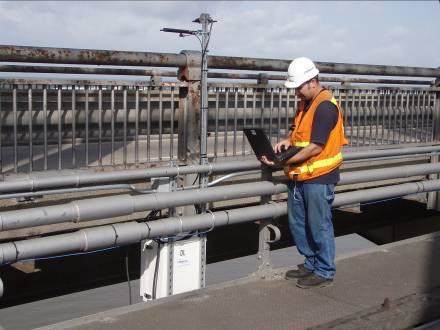




The four main spans of the Huey P. Long Bridge extend nearly 2400 ft over the Mississippi River in New Orleans, Louisiana. This cantilevered steel through-truss bridge opened to traffic in 1935 and is owned and operated by the New Orleans Public Belt Railroad. The bridge currently carries dual rail lines between the trusses and two lanes of vehicular traffic cantilevered to the exterior of each truss. Based on the need to improve vehicular traffic flow and constraints due to uninterruptible rail traffic, the Louisiana Department of Transportation and Development (LA DOTD) decided to widen the bridge rather than replace it.
CTLGroup was awarded the contract to design and install the truss monitoring system according to the specifications for the Huey P. Long Bridge widening project.
A total of 433 existing truss members are monitored with an array of 827 static and dynamic strain gages designed to measure axial and bending load effects. In addition, tilt meters monitor the inclination of the piers. For the static system, CTLGroup chose vibrating-wire strain gages based on cost, built-in temperature compensation, and the ability to run long distances with lead wires.
The truss-monitoring data-acquisition system is composed of a static-load monitoring system and a live-load monitoring system. The static system uses 23 track-side-mounted NEMA enclosures that contain AM16/32B multiplexers and AVW206 spectral-analysis modules to read the vibrating-wire strain gages. In addition, five piers are monitored using ten vibrating-wire tilt meters as well as ambient temperature, wind speed, and wind direction sensors. Wireless communication—saving miles of cabling and hundreds of hours of labor—is accomplished using the spread-spectrum radio built into each of the AVW206 analyzers and an RF401 spread spectrum radio at each CR1000 datalogger and at the central computer.
With hundreds of vibrating-wire sensors involved, this monitoring project provided an appropriate setting to apply the new spectral-analysis method. The outcome was very positive. Historically, an application with so many vibrating-wire measurements would require extra effort to validate measurements and identify noise-compromised data. Typically, some data would be lost due to noise interference. In this case, however, spectral analysis eliminated noise issues. No data were lost, and no extra effort was needed to identify noise-compromised data.
The diagnostics provided by the new method also proved to be beneficial, and have been used extensively throughout the project. CTLGroup reported that troubleshooting issues could not have been as easily resolved without the AVW206. Though they have previously used time-domain solutions, this experience has put them solidly behind the spectral analysis method.
Case Study Summary
Application
Monitoring bridge stresses during wideningLocation
New Orleans, LouisianaProducts Used
AM16/32B CR1000Contributors
Tom Weinmann, CTLGroupParticipating Organizations
Louisiana Department of Transportation and Development (LA DOTD)Measured Parameters
Dead-load stresses, construction-related stresses, tilt, air temperature, wind speed and directionView the PDF